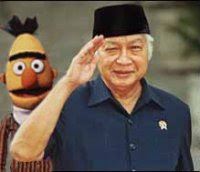
The KPK saga has certainly been a bit of a reality check. From some international media reports you'd think that the country had transformed itself into some kind of post-Fordist, techno-capitalist paradise over the last five years. Sure, there was a peaceful election but the Indonesia I stick my head out of my front door into seems pretty much the same as ever. Except in one respect though: namely that everyone from 'ojeg' drivers to fried rice sellers to maids are all pumping some kind of handheld device as if their very lives depended on them (which perhaps they do, as calling or texting a regular 'ojeg' driver to come and pick them up is becoming an increasingly common occurrence amongst acquaintances of mine).
This week, this paper reported that shoppers queued for hours to get their hands on the latest Nexian mobile phone. The item in question costs only Rp.599,000 and allows one to use Facebook. Most importantly however, as many of the shoppers confessed, the thing looks almost exactly like a Blackberry. The Blackberry is currently the de rigueur item of urbane urban sophistication of course and has elevated techno-fetishism to a new level in Indonesia. Between January and June of this year, mobile advert requests on Blackberry telephones increased by a whopping 842%.

Post-modern, post-Marxist critiques of capitalism have tried to get a handle on such consumer lust and have theorized that there are four main ways in which an object obtains value. The first is its functional value, its instrumental purpose. A pen, for example, writes, or a Blackberry can be used to surf the Internet or call someone up. The second is the object’s exchange or economic value. One Blackberry may be worth three imitation Chinese models, or the salary earned by three months of work, for example.
The third value making process is an object's symbolic value. This is the value that the subject assigns to an object in relation to another subject. For example, a diamond ring may be a symbol of publicly declared marital love. Similarly, a Blackberry may symbolize a person's rite of passage into the tech-savvy, urban elite. The last value is the sign value of an object, namely its value within a system of objects. A particular phone or mobile device may, whilst having no functional benefits, signify prestige relative to another mobile phone and may also suggest particular social value such as taste, class and refinement.
The first two values here, it is argued, are constantly and increasingly disrupted by the third and fourth. The consequences of this are that advertising and public relations have become huge worldwide "industries", ones that increasingly subsume even politics and ideologies themselves.
I myself am not always able to resist such techno-consumerist seductions, despite hating our new Blackberry republic with a vengeance (mainly because the thing's buttons are too damned small for my sausage like digits to cope with). I was thus powerless to prevent myself from popping along to the JCC last weekend to check out the latest technology trade fair.
Inside, the Hewlett-Packards and Sonys of this world mixed with cheaper Sino-Asian silicon, and all were lovingly presented by some very comely sales girls. Blackberry knickknacks were all over the place, of course, however the new Windows 7 operating system was also attracting a lot of attention. The various different versions of Microsoft’s new baby were all going for around the Rp.1,000,000 mark. A lot cheaper than in the West for sure but, on the other hand, considerably more expensive than buying a pirated version for Rp.50,000 from Ambassador Mall, or plumping for the increasingly popular open source option (Ubuntu 9.10 has just been released to much geek fanfare and rustling of anoraks).
Local Internet dongles (Telkomsel, Speed Up, Smart, XL Connect) were all on sale and all offering speeds of, "Up to 3.1 Mbs". I should imagine that "Up to" are the operative words here. Also, a mini netbook computer can now be had for around Rp.3,500,000, which is cheaper than a decent Blackberry.

I resisted splashing out on my real objects of techno-lust (a fancy midi keyboard and a pair of extremely sexy Sennheiser headphones) and instead made a more modest purchase. I found one of those Micro-SD cards, the ones that are about the size of a pinky nail for putting in mobile phones, that had a whopping 16Gb capacity. When I first bought one of these minute slivers of memory about five or six years ago it only had 128Mb to play with. That's a storage increase of 125 times. Amazing. If only my wetware noggin could keep up with all of this.

